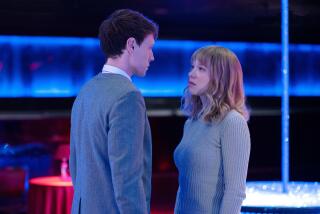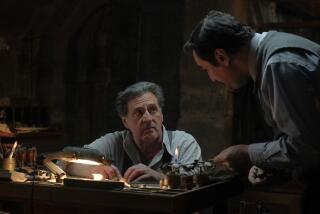From the Archives: Jean-Luc Godard’s 1965 film ‘Pierrot le Fou’ dazzles with potency
Editor’s note: A newly restored version of “Pierrot le Fou” opens Friday at the Cinefamily. Below is the 2007 review of its last Los Angeles reissue.
Jean-Luc Godard’s films have always reflected the times in which they were made with their acute, even startling ability to evoke self-recognition, yet so rich and far-ranging are their concerns that it is hardly surprising they seem timeless. Such is the case with the dazzling “Pierrot le Fou” (1965), which could just as easily be unfolding now instead of 42 years ago. It is best remembered for an appearance by director Samuel Fuller, playing himself as a party guest and famously defining cinema thus: “The film is a battleground: love, hate, action, violence, death — in one word, emotion.” “Pierrot le Fou” is all that plus intellect.
“Pierrot’s” plot instigates much action, considerable humor, eventual pathos and a torrent of thought. Ferdinand (Jean-Paul Belmondo), a young intellectual who says he’s “in television,” possibly as a talk show personality, has married a rich Italian (Graziela Galvani) and is ensconced in a luxurious, consumerist bourgeois existence when the new baby sitter for his little daughter turns out to be his former lover, Marianne (Anna Karina). She is running away from a pack of gunrunners, and in a flash Ferdinand is on the run with Marianne, heading for the South of France, with the hope of getting to Italy and flying off to Tahiti.
SIGN UP for the free Classic Hollywood newsletter >>
In the first shot of Ferdinand, whom Marianne insists on calling Pierrot, he is in a bathtub reading a passage on the Spanish painter Diego Velázquez to his infant daughter. The passage, from Élie Faure’s “The History of Art,” states that after age 50 the artist “never painted a definite object” but rather the space between objects. This statement is the key to understanding “Pierrot,” referring to the space between Marianne and Ferdinand, between Ferdinand and the Pierrot that Marianne sees him as, and — as has been pointed out by others — between reality and fantasy. Many filmmakers explore the interplay between reality and fantasy, but Godard here goes a step further by insisting that the viewer always be aware that it is fantasy that he or she is watching. It’s a stance that pays off in layered meanings and intricate implications.
Godard has in this way set in motion what has been succinctly summed up as an “an existential Bonnie and Clyde,” a freewheeling lovers-on-the-lam adventure that is light and lyrical but also dark and contemplative. Godard’s trademark torrent of references and aphorisms is typically wide-ranging, but here they often have a specific and direct application, such as Godard’s homage to Jean Renoir’s “La Chienne.” There’s a tip of the hat to Laurel and Hardy, to Edgar Allan Poe and on and on. There are even singing and dancing interludes; Godard understands the potency of popular music.
SIGN UP for the free Indie Focus movies newsletter >>
He inspires in Belmondo and Karina, at the height of their careers and physical attractiveness, two of their finest performances. Belmondo moves with the athletic grace of the boxer he had been yet plays a complex, reflective intellectual with the ease and poignancy he brought to his Bogart-idolizing petty thief in Godard’s “Breathless.” Karina is always an enchantress, but here she is required to be as treacherous as she is beguiling, and there’s a quicksilver quality in both her and Belmondo’s portrayals. Indeed, “Pierrot le Fou” is arguably most “real” on its personal level, an expression of Godard’s frustration and pain over losing Karina, his beautiful and beloved muse, who in fact made this film after she had broken up with Godard.
“Pierrot le Fou” (“Crazy Pete”) is pivotal in Godard’s career. At the time of its release, he said that before making it he had grown pessimistic toward cinema, feeling that “there was nothing left to do.”
“After ‘Pierrot,’ I no longer feel this,” Godard said. In a very real sense, Godard is casting off the classic genre lovers-on-the-run plot and moving toward a form that has been aptly described as an essay embracing an apocalyptic vision — one he maintains right through his most recent releases. So challenging and prolific has been Godard’s 53-year career that virtually all of his films are as deserving of revival as “Pierrot le Fou.”
“Pierrot le Fou”
In French with English subtitles
No MPAA rating
Running time: 1 hour, 50 minutes
Playing: The Cinefamily at the Silent Movie Theatre, Los Angeles
More to Read
Only good movies
Get the Indie Focus newsletter, Mark Olsen's weekly guide to the world of cinema.
You may occasionally receive promotional content from the Los Angeles Times.






